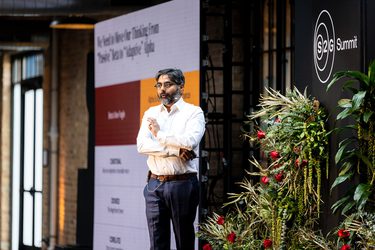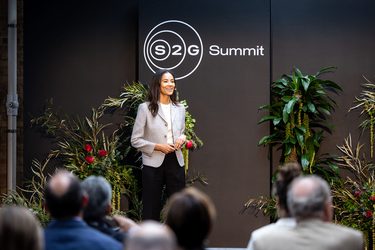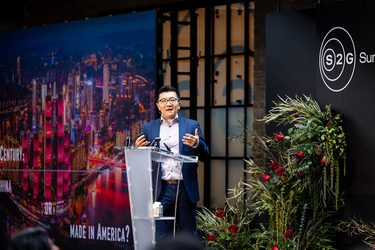
S2G Summit: The Age of Adaptation



We just wrapped up this year’s S2G Summit, our annual gathering of industry executives, innovators, investors, policymakers, and influencers shaping the future of food & agriculture, oceans, and energy. It’s always a privilege to bring this community together, reconnect with familiar faces, spark new collaborations, and engage in face-to-face conversations that make this work more meaningful and move ideas into action.
This year’s summit convened a dynamic community of stakeholders, including over 150 companies spanning our three sector areas of focus from startups to large corporations, 100 investors across the capital spectrum, 14 banks, 41 industry groups, and 13 philanthropic foundations. In aggregate, the attendees represented $3.6 trillion in publicly traded corporate revenue and $27 trillion in total assets under management. The event was a too-brief but critical opportunity to align capital, insight, and ambition toward real, implementable solutions.

Sanjeev Krishnan kicked off the day by setting the stage for the Age of Adaptation — a timely theme when reflecting on the past year. Since our last summit, the world has continued to change rapidly. The last 30 years will be nothing like the next 30 years, and we must adapt as we pivot from an era of moderation to an era of increased volatility. The US has reemerged as a global disruptor. AI has leapt forward in capability and adoption, redefining entire sectors almost overnight. Bond and equity markets have retreated from risk, resulting in historically inverted investor portfolios, and, perhaps most critically, 2024 was the hottest year on record, putting us on an accelerated path towards 2.5 to 3°C of warming. These shifts signal the end of the relatively stable post-Cold War era and mark our entrance into an era of volatility. Geopolitical unrest, inflation, fragmented supply chains, and climate extremes are no longer edge cases — they are defining features of this time. (See the slides, including data points and insights, from Sanjeev’s presentation.)
Sanjeev emphasized that to navigate this era, we must fundamentally rethink how we operate across industries. For business leaders and investors alike, this means shifting from static to adaptive strategies that can absorb shocks and respond to system disruptions in real time. The events of the day were framed around four defining forces that will shape this Age of Adaptation: AI, geopolitical realignment, changing monetary regimes, and climate adaptation.
AI
Artificial intelligence is shifting productivity curves, redefining how value is created and delivered across every sector. As we move from CPUs to GPUs, the computing paradigm is evolving to meet the demands of an AI-first world.
Ranveer Chandra, Managing Director for Research for Industry and CTO of Agri-food at Microsoft, sat down with David Douglas, CEO of Sensei Ag, to explore how AI is transitioning from a productivity tool to essential infrastructure and reshaping how businesses operate. They highlighted the growing “technology overhand” where AI has advanced so far that it could pause today and still take years to fully integrate and understand. From writing code to managing greenhouses, AI is already amplifying top talent and redefining how work gets done, prompting leaders to rethink team structures as “people + AI.” They outlined a phased evolution – from AI Assistants to AI labor to humans managing networks of AI agents. But with this opportunity comes responsibility: As more than 3 billion people remain disconnected from the internet, Chandra and Douglas warned that without thoughtful governance, the AI revolution could deepen inequality and create a concerning global divide.

Sinead Bovell, futurist, entrepreneur, and founder of WAYE (Weekly Advice for Young Entrepreneurs), urged leaders to adopt a systems approach to AI, warning that our tendency to think linearly leaves us unprepared for the exponential nature of technological change. She outlined two phases of AI: first as a product or assistant that optimizes existing workflows, and then as a foundational infrastructure that redefines entire industries, markets, and customer behaviors. In this AI-first future we could see a shift from user-facing interfaces to agent-to-agent interactions. Bovell emphasized that regardless of differing views about the future, the best strategy is to prepare proactively for change.
Geopolitics
Geopolitics are undergoing a seismic shift — realigning global trade and industrial policy, fragmenting long-standing supply chains, and reshaping the rules of engagement. As we move from a unipolar to multipolar world, the rules of economic and strategic engagement are being fundamentally rewritten.

Damien Ma, Founder of MarcoPolo and faculty member at the Kellogg School of Management, explored China’s rapid rise and its role in shaping a multipolar world defined by industrial ambition, innovation, and scale. He drew a stark contrast between the timing of urban development in the US and China, underscoring China’s modern infrastructure and capacity to build incredibly efficiently. From AI talent pipelines to dominance in clean tech manufacturing and a head-to-head race with the US on commercialized fusion, China’s competitive edge lies in its ability to mobilize capital, policy, and markets simultaneously. Ma argued that the US must not only rethink its industrial strategy but also rediscover its own ability to compete in an age of tech transformation.
Dr. Julia Nesheiwat, VP of Policy and Insights at TC Energy, spoke to Gayle Tzemach Lemmon, President of GTL Group, about how geopolitical instability, extreme weather events, and rapid technological change are reshaping global energy systems. Drawing from her experience across the White House, State Department, US Department of Defense, and private sector, Dr. Nesheiwat highlighted the urgent need to modernize infrastructure and strengthen national energy strategies. She emphasized the critical link between climate adaptation and energy resilience and underscored that in an increasingly volatile world, energy security must be treated as both an environmental and national security imperative.

Chris Barnard, President of the American Conservation Coalition, spoke to Heather Reams, President of Citizens for Responsible Energy Solutions, about his vision for advancing clean energy and environmental stewardship within conservative circles. The conversation explored how a new generation of leaders must bridge partisan divides to drive climate action, shifting the political narrative and growing the demand for pragmatic, market-driven solutions. The session underscored that climate leadership in the US is being redefined by innovation, engagement, and generational change.
JB Straubel, CEO of Redwood Materials and Co-founder of Tesla, spoke with Sanjeev Krishnan about the convergence of energy, AI, and advanced manufacturing as a defining force in the next era of innovation. He emphasized that batteries – and the full ecosystem around them — are central to both electrification and powering the data-intensive future driven by AI, when compute efficiency per kilowatt-hour is the key metric. Straubel noted that despite the politicized narrative around EVs, global sales are hitting record highs, signaling that the transition is accelerating and entering a phase of commoditization. He also underscored the importance of closed-loop systems for critical materials, stressing that we must build robust recycling infrastructure to maintain supply, reduce dependency, and unlock long-term value in low-margin, capital-intensive sectors often overlooked by traditional investors.
Monetary Régime
The global monetary régime is under strain as rising sovereign debt and growing skepticism toward fiat currency systems challenge long-standing financial norms. With the US dollar facing increased volatility, we’re entering a new era defined by an uncertain and shifting price of money.

Dimitris Valatsas, Founding Partner at Aurora Macro Strategies, unpacked the profound shifts reshaping the global financial landscape, highlighting the gradual decline of US dollar dominance amid rising fiscal pressures and geopolitical fragmentation. He explained how aging demographics have long suppressed growth and interest rates through secular stagnation, but this trend is now being upended by a surge in capital-intensive AI investments that drive productivity and create new forms of “information capital.” These changes are fragmenting global capital markets, causing real interest rates to diverge across regions and altering the cost of capital for businesses worldwide. Ultimately, the rise of AI and shifting monetary dynamics call for a fresh understanding of investment, capital, and economic growth in an increasingly complex and technology-driven world.
Climate Adaptation
As the planet warms beyond 1.5°C, climate adaptation is no longer optional — it’s a defining investment imperative. These sessions explored why and how investors and companies can navigate the rising costs and opportunities of a changing climate. The future is not just about risk mitigation, it’s about rethinking value creation.

Dr. Parag Khanna, Founder of AlphaGeo, emphasized the urgent need to shift global focus toward climate adaptation, highlighting resilience as a critical investment opportunity amid escalating climate volatility. He introduced the Sustainability Index, a tool that measures shifts in global livability, suggesting that much of the world’s population is increasingly concentrated in areas that are becoming less hospitable, driving migration and economic disruption, while resilient geographies will become increasingly valuable assets. Khanna made the case that resilience is not a philosophical ideal but a measurable, investable attribute. Proactive strategies like building climate-smart infrastructure, circular food-water-energy systems, and green job markets in climate havens can help us prepare for a more uncertain future.

Spencer Glendon, Founder of Probable Futures, and Barney Schauble, Principal at greenthread, explored how traditional risk models are failing in the face of accelerating climate change, where underlying probability distributions are no longer stable. They emphasized that most financial systems still rely on historical assumptions of a stable climate despite clear evidence that we’ve moved outside of the “green band” of the last 12,000 years. As insurers retreat from high-risk markets and deny coverage, the burden is shifting to local governments and communities, who are often unprepared to shoulder it. Glendon and Schauble’s message was clear: Adapting to a climate-altered future requires rethinking the very systems we use to understand and respond to risk.

Dr. Ashby Monk, Executive Director at the Stanford Research Initiative on Long-Term Investing, delivered a compelling call to action that institutional asset owners — like pension and sovereign wealth funds — must evolve beyond traditional notions of robustness, designed merely to withstand shocks, and instead embed resilience as a core investment principle. These institutions allocate capital with decades-long time horizons, yet most current models don’t account for the scale and complexity of structural, long-term risks ahead, including climate change, geopolitical instability, and social structures. Dr. Monk introduced the DARLing framework — Detect, Absorb, Recover, Learn — as a model for building resilient portfolios that not only survive market shocks but emerge stronger.
Following an opening video from fellow Co-founder Matt Damon, Gary White, Co-founder and CEO of Water.org and WaterEquity, joined Chuck Templeton to share the evolution of his organizations. What began as a nonprofit mission rooted in compassion has since transformed into a scalable, market-driven approach that channels capital toward sustainable water solutions in underserved communities. White shared the critical mindset adjustments he and his team embraced to move beyond traditional aid models — shifting from charity to empowerment, and from short-term relief to long-term resilience. The conversation underscored how addressing the global water crisis requires more than good intentions. It demands innovative financing mechanisms, cross-sector collaboration, and a bold commitment to systemic change. By leveraging the power of markets and mobilizing billions in capital, Water.org and WaterEquity are demonstrating what’s possible when impact and scale go hand in hand.

The Age of Adaptation will be a time of both heightened risk and remarkable opportunity. Our ability to adopt and adapt as we navigate a volatile world will demand bold ideas, more resilient strategies, and collective action. As we closed out the 2025 S2G Summit — our eighth annual convening and a celebration of ten years since our very first S2G Summit gathering — we are filled with deep gratitude for the opportunity to come together with such an inspiring and committed community. Thank you for your partnership, your passion, and your belief in the power of collaboration. We look forward to many more shared moments of connection, innovation, and impact in the year ahead.
Photo Credits: Dietz Studio


